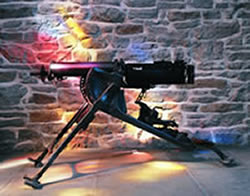It’s 1960 and H.G. Wells, played by actor Rod Taylor in the film classic The Time Machine, climbs into an invention that can take him into the misty past or the unimaginable future.
Wells’s unnatural vehicle does not rust or crack while travelling through the years, although everything around it ages radically. I think of this movie when I look at the machine gun that stands innocuously in Soldiers’ Tower, one of two captured from the Germans at Vimy Ridge on the morning of April 9, 1917, by Maj. Thain Wendell MacDowell (BA 1915 VIC, MA Hon. Causa 1919). He, too, had travelled to an unimaginable landscape, and by all accounts had shown immense bravery in capturing these guns (the other went missing from campus in the 1970s). MacDowell continued to fight, for five days, under heavy fire while wounded in the hand until relieved by his battalion. After 86 years the gun still looks in near-perfect condition, on display in the memorial room that houses portraits of the dead, medals of the brave, bibles of the frightened. But lay your hand on that cold steel weapon and the stone walls melt away, the framed faces blur. Smell blood, feel mud, hear screams. Look down the barrel and envision bullets finding their mark on the faces of fathers, sons, brothers and uncles covered in wet, foreign dirt. Suddenly it’s 1917, and this time machine is taking you for a ride.





